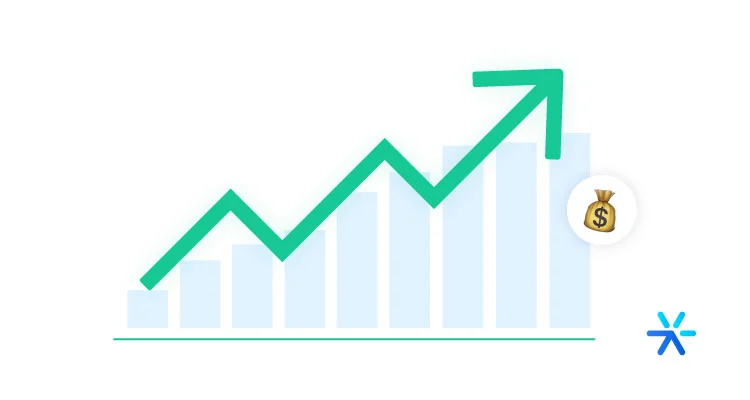Marketing ROI: What It is and How to Calculate It
Investing in marketing can seem complex with so many options and tools available today.
Moreover, just as important as creating and executing actions is understanding how they are bringing returns to your company.
Investments in digital marketing have provided an advantage in this type of analysis and measurement.
Since the data is more complete, specific, and detailed, it becomes easier to monitor how many people were impacted by the campaigns and what the actual return was for each of the strategies.
We have already covered topics on other metrics like Customer Acquisition Cost and Number of Qualified Leads here on the blog.
In this article, we’ve prepared content to discuss another important metric for the healthy development of your business and the success of your company’s marketing: ROI.
What is ROI in marketing?

ROI stands for “Return on Investment.”
This is one of the most important metrics for the company and deserves your constant attention and monitoring.
This is because ROI calculates how much money the company earns or loses from the investments made.
ROI is mainly monitored when we talk about marketing investments, related to the costs of strategies in this sector.
This allows you and your team to control the results of campaigns, actions, and new marketing strategies implemented.
How to calculate the ROI of a marketing campaign?
To calculate ROI, you need to have some other data on hand.
First, you need to determine the total revenue during the chosen period.
Then, you need to sum up all the investments in marketing campaigns during the same period.
The formula for calculating ROI is as follows:
ROI =
Total Revenue – Marketing Investments/ Marketing Investments
For example, let’s say your company ran a six-month marketing campaign and wants to measure the marketing ROI for this period.
During the campaign, a total of 20,000 reais was spent on marketing actions.
And the total revenue gain for your company during the period was 100,000 reais. Therefore:
ROI = (100,000 – 20,000) / 20,000 = 4
In the example we created, the return on investment was four times, or 400% compared to the initial investment.
Furthermore, to calculate your marketing ROI, it’s not enough to just plug values into the above formula; you can also analyze it through other metrics that impact your business.
After all, not all marketing campaigns have the final goal of sales and conversion. Therefore, looking only at the “money” that certain actions brought may give you a skewed view of your marketing process.
With this in mind, we’ve listed the 5 most used digital marketing metrics to help you measure ROI, check them out:
Conversion Rate
Widely discussed in marketing, the conversion rate is one of the most used metrics to track return on investment over time.
After all, if your campaign goals are to convert, conversion metrics will tell you whether you are achieving them or not. In other words, through this metric, you will know what you are doing well and where you can allocate your resources to get better results and better return on investment.
Not stopping there, within the conversion rate, we have some elements to detail and monitor, such as:
- Channel – Know where your traffic is coming from, so you can invest in the media that have the highest return.
- Device – Do your campaigns convert more on mobile or desktop? This information is essential to know where to invest more and how to optimize for the best devices.
Remember that the conversion rate can be calculated as follows:
Conversion Rate = (Total Conversions / Total Visitors or Leads or Opportunities) x 100
Want to benchmark your conversion rate? See if yours matches the standard for your segment in the 2024 Lead Generation Panorama!
CPL
Now, if your campaign goal is to collect new leads for your sales team to close, you’ll need to calculate your ROI along with the cost per lead, that is, measure how much you are paying for each new lead.
Remembering, the CPL formula is:
CPL = Marketing Investment / Number of Leads Captured
With this analysis, it will be possible to determine the return on investment for each new lead generation campaign.
If you find that the cost of each lead is higher than the capture strategy itself, know that you are not obtaining a positive return on investment.
Lead-to-Sale Conversion Rate
In addition to acquiring new leads, it’s important to track which ones actually became your customers.
To do this, paying attention to the lead-to-sale conversion rate is essential when analyzing the effectiveness of your marketing campaigns.
You can compare your rate with the leads being generated and thus understand how your profitability is doing.
CPA
CPA, cost per acquisition, tells you how much it costs on average to acquire a new customer.
It’s almost like ROI, but less detailed. Think of it as analyzing how much acquiring each customer costs in total, regardless of where they came from.
Therefore, analyzing it alongside ROI will be crucial to understand whether you are spending more to acquire a customer than they actually bring to your company.
LTV
Last but not least, Lifetime Value is the metric that defines the value of your customer’s lifecycle.
With it, you will be able to look at long-term profit, offering a new perspective on initial acquisition costs and your ROI.
To calculate LTV, use the following formula:
LTV = Average Customer Ticket × Average Purchases per Year × Customer Relationship Lifecycle
What is a good marketing ROI?

The answer to this question can vary; after all, ROI varies depending on companies and campaigns.
But generally, a good marketing ROI is one that brings a positive financial return to the company, meaning the profit generated by the marketing campaign is greater than the amount invested in it.
However, while some companies are satisfied with an ROI of 2:1, meaning every R$1 invested generates R$2 in financial return, others aim for a higher ROI, such as 5:1 or even 10:1.
On the other hand, we should also keep in mind what constitutes a poor ROI. A negative ROI is when a marketing campaign generates more expenses than profits.
Even a low ROI can be considered an unsatisfactory result, even if it’s positive. For example, an ROI of 1.1:1 might indicate that the campaign generated some profit but not enough to justify the investment.
What is ROI for, and why is it important?

By calculating ROI, you can identify which investments yield the best returns or which marketing campaigns were the most successful.
🔎 Read also: Business Marketing: Where to Start? 5 Current Marketing Tips
It is also quite relevant in other strategic aspects:
- Team morale: Good performance rates boost the motivation and pride of the teams. The marketing team’s success in bringing results to the company will reinforce the importance of the department and foster a more stimulating work environment.
- Increased profits: Paying attention to ROI means focusing on optimizing investments. If the company’s money is employed in the right places, the result will be an increase in profit margins.
- Better goal-setting: Data analysis and historical investment tracking also make it easier to set assertive goals aligned with the business’s purpose. With clearer objectives, investment and effort distribution also improve.
- Lower costs: Analyzing return on investment also allows for the cutting of unnecessary expenses, a more critical evaluation of heavily supported actions, and greater confidence in decision-making.
- Long-term results: Monitoring results according to return on investment also brings long-term transformations for companies. Teams begin to develop an analytical mindset, and work becomes more results-focused.
What are the limitations of ROI?
ROI in marketing is an excellent metric to track, but it’s important to note that there are some caveats when using it to monitor the success of the actions taken.
The main one is that it’s not so simple to define a good benchmark for what is or isn’t a good return rate.
But there are still others:
Does not account for inflation:
ROI does not consider value fluctuations due to inflation, whether an increase or decrease.
Let’s say your company had a 10% ROI on marketing investment.
With current inflation, most of that value would be dissolved by inflation.
Thus, your real return wouldn’t be 10%.

Does Not Account for Seasonality
Another negative aspect is that ROI does not account for seasonality, which is a very determining factor for marketing and sales actions.
Especially in certain market segments, such as car sales or products for specific dates, sales are socially and culturally driven.
Not considering these seasonal factors may obscure negative results during certain periods.
Does Not Consider the Duration of the Investment
The ROI calculation does not change for short campaigns, such as one week, versus longer periods, such as an entire year.
Imagine a company had a high investment only in the first month of the year and then drastically reduced this amount.
When calculating the annual ROI, the value will not take into account this variation, considering only the total data.
The Calculation Can Be Manipulated
You need to ensure that everyone involved in the process is aligned with the detailing of values for the marketing ROI calculation.
This is because, as we are talking about summing many elements to reach the total revenue and investment values, a data entry error or a lack of alignment can result in a number that does not correspond to reality.
How to Maximize Your ROI?

To improve your ROI, you need to optimize your investments.
Thus, with money allocated to the right strategies, your marketing costs will yield more return, and consequently, increase your company’s ROI rate.
Here are some tips for you to apply:
Set Clear Objectives
Before jumping into practice, to improve your return rates, it’s worth taking a step back and spending ample time on planning.
By analyzing data and historical investments made so far, it becomes easier to define the goals you want to achieve.
With clearer objectives, you will know how to allocate investments and track whether the goals are being met throughout the campaign.
Moreover, if things do not go as planned, you can always review and adjust the strategies.
Another advantage enabled by digital marketing!
Use CRO as Well
CRO stands for Conversion Rate Optimization.
By implementing actions for this type of optimization, you increase your conversion rates and thus improve your investments.
If your conversion rates are very low, it means you are spending to attract people to your site, blog, or landing pages, but they are not taking any action from there.
This is a sign of negative investment.
Conversational Marketing
One of the most current ways to improve conversion rates is to use Conversational Marketing tools.
Through chatbots and virtual assistants, you can impact visitors to your pages in a personalized, dynamic way, and increase your conversion rates by up to three times.
Additionally, it is also a way to generate better-qualified leads.
Understand Each Stage of the Prospect
We discussed qualified leads in the previous section.
But what does this mean?
Not always offering your product or service right away in an ad or campaign is the best option for selling.
This is because consumers are bombarded with information and offers every day, all the time.
And not all of them are ready for this decision-making phase.
This is what we call the “Buying Journey” in marketing and sales.
Between the first contact and the acquisition of the solution your company offers, the consumer needs to build trust, develop a relationship, and mature their need to buy.
From the company’s perspective, this means qualifying leads.
In other words, transforming contacts into increasingly interested consumers until they become your customers.
So, to improve the return on marketing investments, understand the different stages of the journey.
This way, you will also better know how to allocate actions and how to engage with the consumer at each stage of the buying maturity.
Segment Each Campaign
One way to impact consumers at different stages of the Buying Journey, with the right type of communication and offer, is to invest in campaign segmentation.
Today, paid media tools like Google Ads and Facebook Ads offer many possibilities for targeting and reaching very specific audiences.
Align the Campaign According to Your Goal
Think about the objectives outlined at the beginning of the planning and understand what type of ad will be most relevant for each stage of the buying journey.
Do you want to attract new people?
Do you want to impact people who have already had some contact with your brand?
Do you want to work with offers for those who have already purchased from you once?
The ads and investment distribution within the campaign need to align with the goal set for it.
Provide Detailed Targeting
Today, it’s possible to segment campaigns based on consumption and behavior data of each user.
So, use the information provided by the ad platforms.
You can segment your campaigns based on interest, consumption habits, demographic data, age range, professional occupation…
There are various options to explore and test.
Use Email Lists
Did you know you can use your contact list to create targeted ads?
Let’s say you want to reach contacts who have already requested a quote from you but have not yet closed a deal.
Tools like Facebook Ads allow you to upload your email lists and target those using these emails on social networks.
The reverse is also possible.
If you want to target only new contacts, you can upload lists and exclude those leads from the campaign segmentation.
Use Retargeting
Retargeting and remarketing are also excellent ways to segment your campaigns.
With this type of strategy, you can target only people who have already visited your site, blog, landing pages…
And you can even choose specific pages for each ad to be displayed.
The chances of catching the attention of people who have already interacted with your brand are much higher.
Nurture Leads
Another way to work with each stage of the Buying Journey is to use lead nurturing.
Lead nurturing is crucial for guiding the consumer through the entire buying journey, keeping and increasing their interest in your brand and the solution you offer.
It is also a way to provide content and offers according to each stage of buying maturity.
Here, it is worth using automation tools, which facilitate the execution of these actions and interactions.
Invest Gradually Until Validation
As mentioned at the beginning of the tips for improving your marketing ROI, you have the option to adjust the campaign while it is still running.
Digital marketing tools have this advantage over some offline marketing investments.
In addition to changing investment values, you can also conduct tests, track performances, and invest more intensively in the campaigns and channels that are yielding the best returns.
Make your decisions based on data.
Create Reports with ROI for Each Campaign
To avoid relying solely on the information within each platform and investment channel, centralize all data into a specific and more detailed report for each campaign.
In addition to facilitating decision-making while the campaigns are ongoing, you will also have, in the long term, a complete history of your company’s marketing actions.
How to Create an ROI Report?

For this complete report, start by defining whether you will track other metrics besides marketing ROI, such as Customer Acquisition Cost.
Additionally, identify the campaign, the monitoring period, the objectives, the expenses, and the results.
Define the Audience
Here, we are not referring to the campaign audience but to whom the report will be presented.
Different data matter to marketing analysts and to the CEO of a company, for example.
Therefore, understand who will access the report and choose the metrics that will be monitored from this perspective.
Define the Metrics
An effective report doesn’t need to be overly extensive and data-heavy.
Focus on what is relevant to the strategy.
And, based on the analysis of who will access this report, define the metrics according to what is of interest to the audience.
Choose the Frequency
This needs to be well-aligned, especially if the report is updated by more than one professional on your team.
Also define the frequency of the report’s updates.
Additionally, define the frequency with which this report will be presented to higher-level positions, such as management and executives.
Know How and Where to Extract Metrics
Use the right tools to extract all data according to the channels and investments made.
The professionals most suited to fill in each metric are those who follow the campaign daily, but it’s a good idea to align with them a guide so that everyone can access the data and know how to extract it.
Create a Template
The next step is to choose how this report will be presented.
Here, the most important thing is that it should be easy to interpret, visual, and quick.
And, of course, also simple to update.
The majority of your marketing team’s time and effort should be spent on data analysis and strategy, not on filling out a report.
Perform Analysis
Not all data may immediately provide the most important information for the business.
Therefore, the data analysis part is crucial in reports.
Some ways to present these analyses are:
- Action and Reaction: What were the results directly obtained from the actions taken and the results that were missed due to actions not developed (in case of cuts, for example);
- Correlation: What were the experiences and results of each channel and the campaign’s outcomes;
- Benchmarking: How the metrics compare to the market.
3 Statistics on Marketing ROI
Nothing better to understand more about ROI than looking at some statistics that represent it within marketing campaigns, right?
Here are three statistics you might find inspiring:
For every dollar spent on email marketing, companies earn $40 in ROI
According to a 2023 Smart Insights study, email marketing has one of the highest returns on investment.A return of $30 in revenue for every $1 spent was calculated—a remarkable value.
More than 70% of companies attribute their success to tracking content marketing ROI
According to a study by the Content Marketing Institute, 72% of the most successful companies calculate their content marketing ROI compared to 22% of the less successful companies.
This result highlighted the importance of determining whether the content produced is helping to drive your business.
Marketing professionals who calculate their ROI are 1.6 times more likely to receive higher budgets
A report from HubSpot shows that marketing professionals who calculate their ROI are receiving higher budgets from their companies.
In other words, it is becoming increasingly necessary to be familiar with how to calculate the return rates of your marketing campaigns.
By doing this, you can show your supervisors and managers the positive impact of marketing, which in turn will build more trust in your work and lead to a larger budget.
Extra: What is SEO ROI?

To wrap up our comprehensive content on ROI, let’s understand what SEO ROI is:
SEO ROI means return on investment in search engine optimization. This metric is used to assess the performance of a website optimization strategy to improve ranking in organic search results.
We can calculate SEO ROI by dividing the value generated by the SEO strategy by the cost invested in it.
The generated value may include increased organic traffic, increased conversions, increased sales, and other various metrics, like those mentioned above, that contribute to business success.
Here’s an example:
If a company invests $5,000 in SEO (outsourced team, tools, internal team, etc.) and as a result sees an increase of $10,000 in sales, then the SEO ROI would be 100%.
$10,000 – $5,000 = $5,000
$5,000 / $5,000 = 1
1 x 100% = 100%
It is also important to note that SEO ROI may take some time to be realized, as search engine optimization is a long-term strategy that requires continuous investment and adjustments over time.
Ready to profit more and make better decisions with ROI tracking in marketing?
This metric has a profound impact on the success of your company’s campaigns and the ability to build an analytical view of them.
Hope you learned what is ROI and understood it’s importance and how to generate a report.
Do you want to increase your ROI starting today? Well, we can help you.
Leadster is a AI powered chatbot that has been proven to increase your lead generation up to 3 times. And you can get started for free today!
Just click on the link and get a free 14 day trial period, no credit card required.








